Ochna
Ochna L.
Family: Ochnaceae
Common names: wild planes, mickey-mouse plants
Introduction
All species of Ochna have very attractive yellow flowers, with an unusual persistent calyx that enlarges when in fruit, becoming cream-coloured, pink or bright red. The fruits are also colourful with black drupelets sitting on a bright red, open receptacle, surrounded by the sepals of the calyx. Species of Ochna such as O. serrulata; O. pulchra and O. pretoriensis are excellent garden plants that will make your garden look magnificent.

Description
Description
The genus Ochna comprises shrublets, shrubs and trees that are usually hairless. The growing tips of the stems are conical and sometimes have overlapping bracts. The leaves are simple, in an alternate or spiral arrangement and the midrib is ridged above and below. There are numerous lateral veins that are parallel, closely spaced and visible above. The margins are usually dentate, with entire stipules or with a fringed margin, or 2-lobed but not so deeply. The flowers are bisexual with floral parts in fives, in solitary or in terminal inflorescences or panicles, often with short, lateral branchlets. The sepals of the calyx are persistent, becoming enlarged, cream-coloured or pink to bright red and petal-like. There are 5-10 petals which are larger than the sepals, but they fall very early after opening. There are many free stamens, about 12 or more with filaments partly persistent. The ovary consists of 1-8 distinct carpels, developing on the swollen red receptacle. The fruits of Ochna are fleshy drupelets with a thin outer layer or coat. They are narrowly ovoid, almost spherical or kidney-shaped and coloured, attached to the base of the receptacle and surrounded by petal-like sepals.
Conservation Status
Status
According to Golding (2002), Ochna afzelioides is critically endangered and O. beirensis is vulnerable in its area of endemism.
Distribution and habitat
Distribution description
There are about 86 species of this genus; found mostly in and around the Mascarene Islands, Africa and Asian countries. In South Africa there are 12 species and twenty species in southern Africa, including Zimbabwe and Mozambique.
Derivation of name and historical aspects
History
The genus Ochna was named by Linnaeus in 1753 and is derived from the Greek word, ochne, which refers to the wild pear, alluding to the leaves that resemble those of the wild pear.
Ecology
Ecology
With such attractive flowers in all species of Ochna, bees and butterflies are favourite companions of these plants. During the flowering season a chorus of melodies is heard as bees visit to draw out nectar. The art of colour exhibition is also witnessed as butterflies glorify the season. These insects assist in pollination of Ochna species. Some bird species find the ripe fruit palatable.
Uses
Use
Only two species seems to be of economic and cultural value: Ochna pulchra and O. serrulata.
Growing Ochna
Grow
The seeds of Ochna species are simple to germinate. Firstly, collect ripe fruits preferably just after dawn. Clean off the outer seed coat and sow immediately after the seed has been removed. Sow seeds in a seedling mix and keep on a heated bed. Keep the seedling mixture damp to assist germination, which takes about 10 days, the time varying with the species. The seedlings prefer sunlight and tend to grow slowly. Regularly remove weeds in the tray, so as to prevent weeds from overshadowing the seedlings.
Species
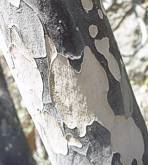
Ochna arborea Burch.ex DC. An evergreen shrub to medium-sized tree, up to 12 m high. The leaves are oblong, leathery and glossy green with serrated margins. The bright yellow flowers are borne in clusters, on short lateral shoots. Flowering time: Aug.-Jan. The ripe fruit consists of 1-5 kidney-shaped, shiny black carpels on an enlarged receptacle, inside the red, petal-like sepals. Fruiting time: Nov.-Feb. The plant occurs in Limpopo, Mpumalanga, KwaZulu-Natal and Eastern Cape, also in Swaziland, Zimbabwe and Mozambique.

O. arborea var. arborea. The leaves are smaller, 24–75 mm long, and slightly serrated to almost entire. The flower stalk is shorter, < 15 mm, and it grows in lowland and forest. The flowers of both varieties of O.arborea are similar.
.
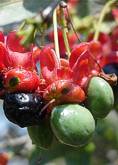
O. arborea var. oconnorii (E.Phillips) Du Toit. The leaves are larger, 68–170 mm long, and prominently serrated. The flower stalk is longer, > 20 mm. It grows in montane forest. The fruits of both varities of O.arborea are similar.
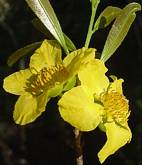
Ochna barbosae N.Robson. A shrub to small tree, 1–8 m, and found in woodland and grassland, on sandy soils along the coast. The leaves are alternate, 30–50 x 12–15 mm, leathery and with prominent green, net veins on both sides. The flowers are yellow and sweet-scented. Flowering time: Aug.–Sept. The fruit is pink to purple, with the spreading sepals of the enlarged calyx up to 15 mm long. There are 5–6 black drupelets. Fruiting time: Nov.–Jan. This lovely tree is found in Kwa Zulu-Natal, Zimbabwe and Mozambique.
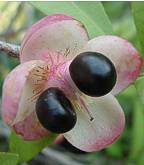
Image is of fruits of Ochna barbosae

Ochna confusa Burtt Davy & Greenway. A multi-stemmed shrub up to 2 m with long, slender, straight branches. The leaves are simple, narrowly elliptic and pale green with serrated margins. The up to six yellow flowers are borne in clusters on short spurs in the axil of a leaf. Flowering time: Aug.–Oct. The ripe fruit comprises of 5 separate round black drupes on a receptacle. Fruiting time: Sept.–Dec. The plant occurs on the hills of Mpumalanga and also Zambia, Zimbabwe, Malawi, Mozambique and Tanzania.

Ochna gamostigmata Du Toit. A shrub or rarely a tree up to 6 m high. The leaves are alternate, simple and elliptic to very narrowly elliptic with serrated margins. The yellow flowers are solitary or rarely in pairs. Flowering time: Sept.–Mar. The ripe fruit consists of 5 separate round drupes on a receptacle, almost enclosed in the red calyx. Fruiting time: Nov.–Mar. This plant occurs in Mpumalanga, KwaZulu-Natal, and Swaziland.
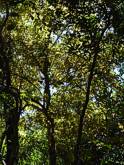
Ochna holstii Engl. A shrub to medium-sized tree, up to 15 m high, with rough, grey-brown stems and branchlets with scattered, pale raised dots. The leaves are alternate, 50–100 x 15–25 mm, with midrib and net veins prominent from above and serrated margins. The yellow flowers, in dense clusters of up to 10, grow on short side shoots. Flowering time: Sept.–Nov. Fruit pink to purple, enlarged calyx with spreading sepals up to 15 mm long, surrounds 5–6 black drupelets. Fruiting time: Nov.–Jan. The plant occurs in forests at altitudes from 900–1 700 m, in Limpopo, Mpumalanga, KwaZulu-Natal, Eastern Cape, and also in Swaziland, Zimbabwe and Mozambique.

Ochna inermis (Forssk.) Schweinf. A multi-stemmed shrub or small tree. The leaves are clustered on short spurs, elliptic to almost circular, 20–60 x 10–60 mm, with margins finely serrate. The yellow flowers are solitary or in pairs. Flowering time: Sept.–Nov. Fruit: 1–3 black drupes joined at their bases, enclosed by the red, persistent sepals. The plant occurs in Limpopo, North-West and Mpumalanga, also in Botswana, Zimbabwe and Mozambique.

Ochna natalitia (Meisn.)Walp. A small, evergreen multi-stemmed shrub found on rocky outcrops and in bushveld. The bark is dark and rough. The leaves are alternate, simple and elliptic, 50–200 x 10–45 mm, and dark green with the new leaves red in spring. The flowers, borne in a cluster, are large and golden yellow. Flowering time: Sept.–Dec. The plant is found in Limpopo, North-West, Gauteng, KwaZulu-Natal and Eastern Cape, and also in Swaziland, Zimbabwe and Mozambique. Read more about this plant.
References
- Coates Palgrave, M. 2002. Keith Coates Palgrave Trees of southern Africa, edn.3: 729, 730. Struik, Cape Town.
- Du Toit, P.C.V. & Obermeyer, A.A. 1976. Ochnaceae. Flora of southern Africa 22: 1-12. Botanical Research Institute, Pretoria.
- Germishuizen, G. & Fabian, A. 1997. Wildflowers of northern South Africa. Fernwood Press, Vlaeberg, Cape Town.
- Germishuizen, G. & Meyer, N.L. (eds). 2003. Plants of southern Africa : an annotated checklist. Strelitzia 14. National Botanical Institute, Pretoria.
- Germishuizen, G., Meyer, N.L., Steenkamp, Y. & Keith, M. (eds). 2006. A checklist of South African plants. Southern African Botanical Diversity Network Report No. 41. SABONET, Pretoria.
- Golding, J.S. (ed.) 2002. Southern African plant Red Data Lists. Southern African Botanical Diversity Network Report No.14. SABONET, Pretoria.
- Leistner, O.A. 2005. Seed plants of southern tropical Africa: families and genera. Southern African Botanical Diversity Network Report No.26. SABONET, Pretoria.
- Pooley, E. 1993. The complete field guide to the trees of Natal, Zululand and Transkei. Natal Flora Publications Trust, Durban.
- Schmidt, E., Lötter, M. & McCleland, W. 2002. Trees and shrubs of Mpumalanga and Kruger National Park. Jacana, Johannesburg.
- Van Wyk, A.E. & Malan, S. 1997. Field guide to the wild flowers of the Highveld 24: 166, 226. Struik, Cape Town.
- Van Wyk, A.E. (Braam) & Van Wyk, P. 1997. Field guide to trees of southern Africa. Struik, Cape Town.
Credits
M. Mothogoane & E. Rampho
National Herbarium, Pretoria
August 2009
Plant Attributes:
Plant Type: Shrub, Tree
SA Distribution:
Soil type:
Flowering season:
PH:
Flower colour:
Aspect:
Gardening skill:
Special Features:
Horticultural zones






Rate this article
Article well written and informative
Rate this plant
Is this an interesting plant?
Login to add your Comment
Back to topNot registered yet? Click here to register.